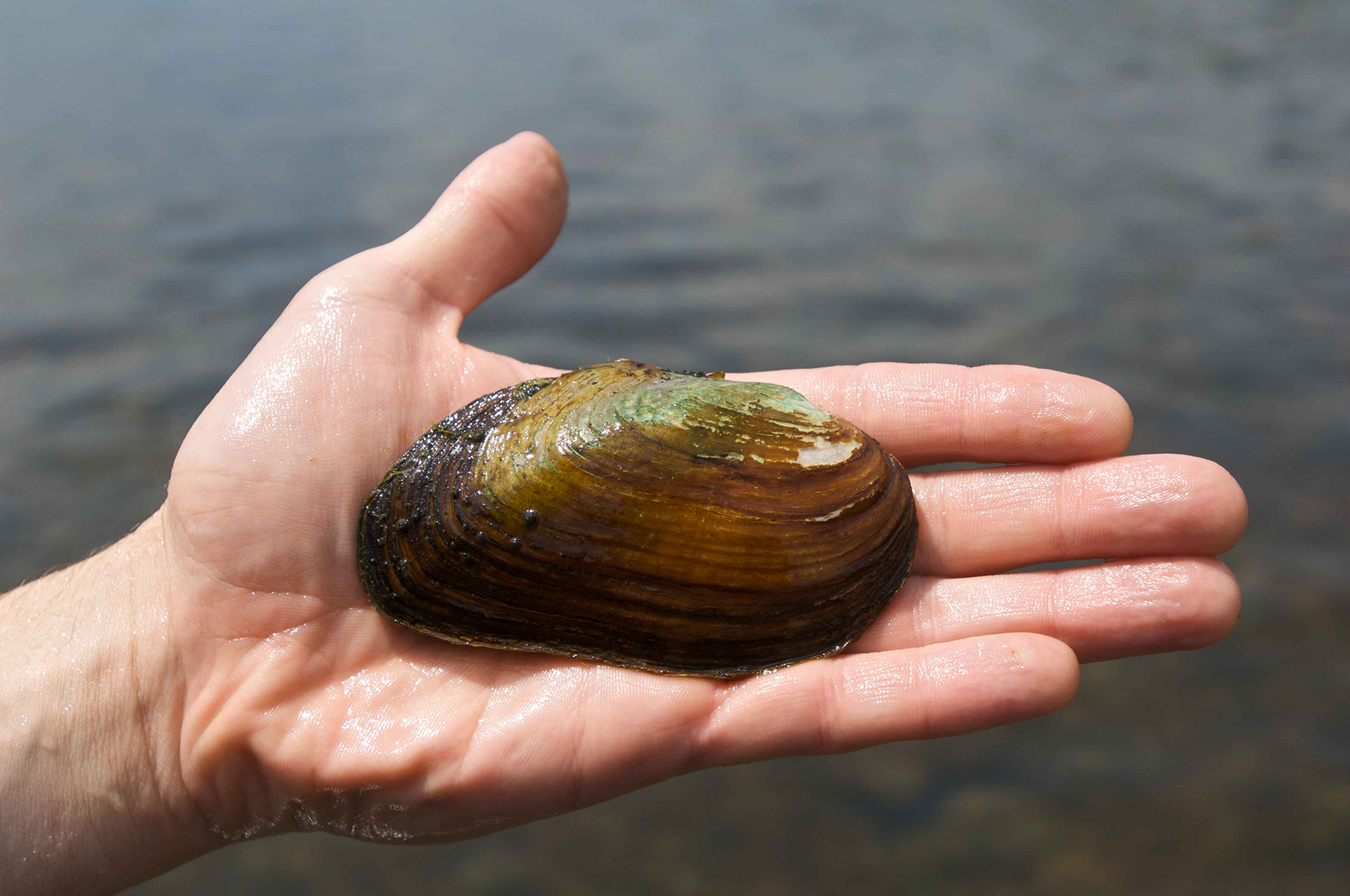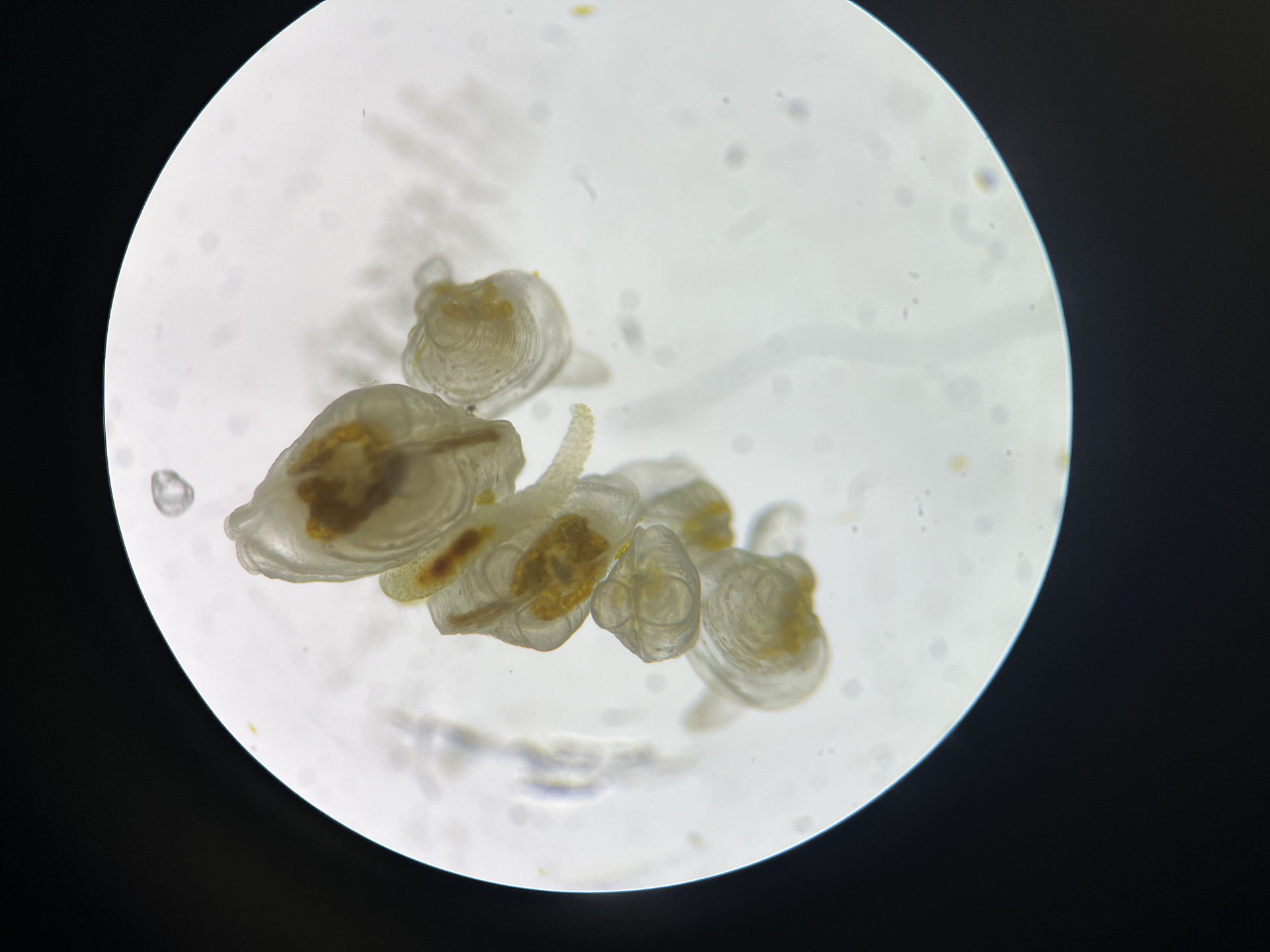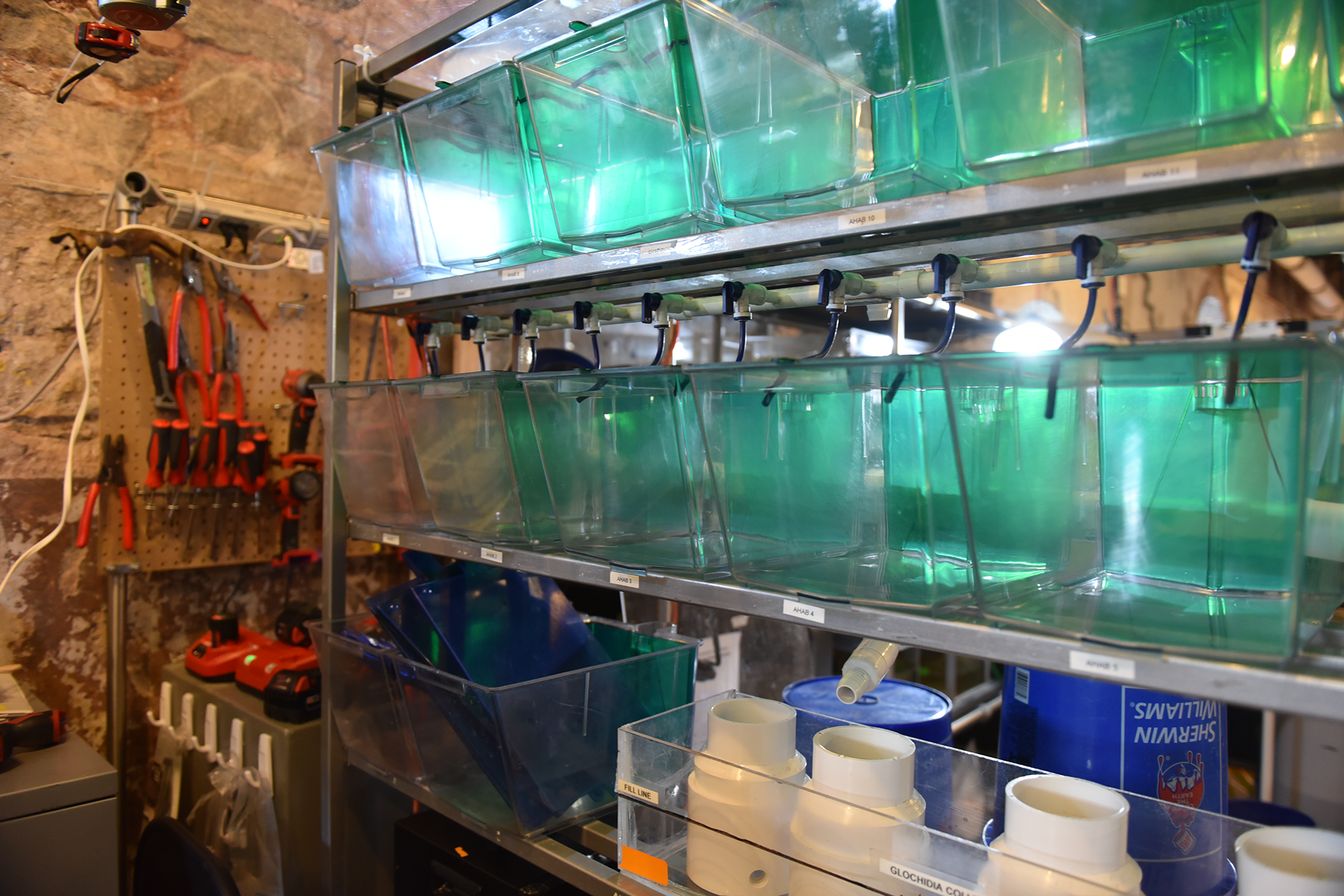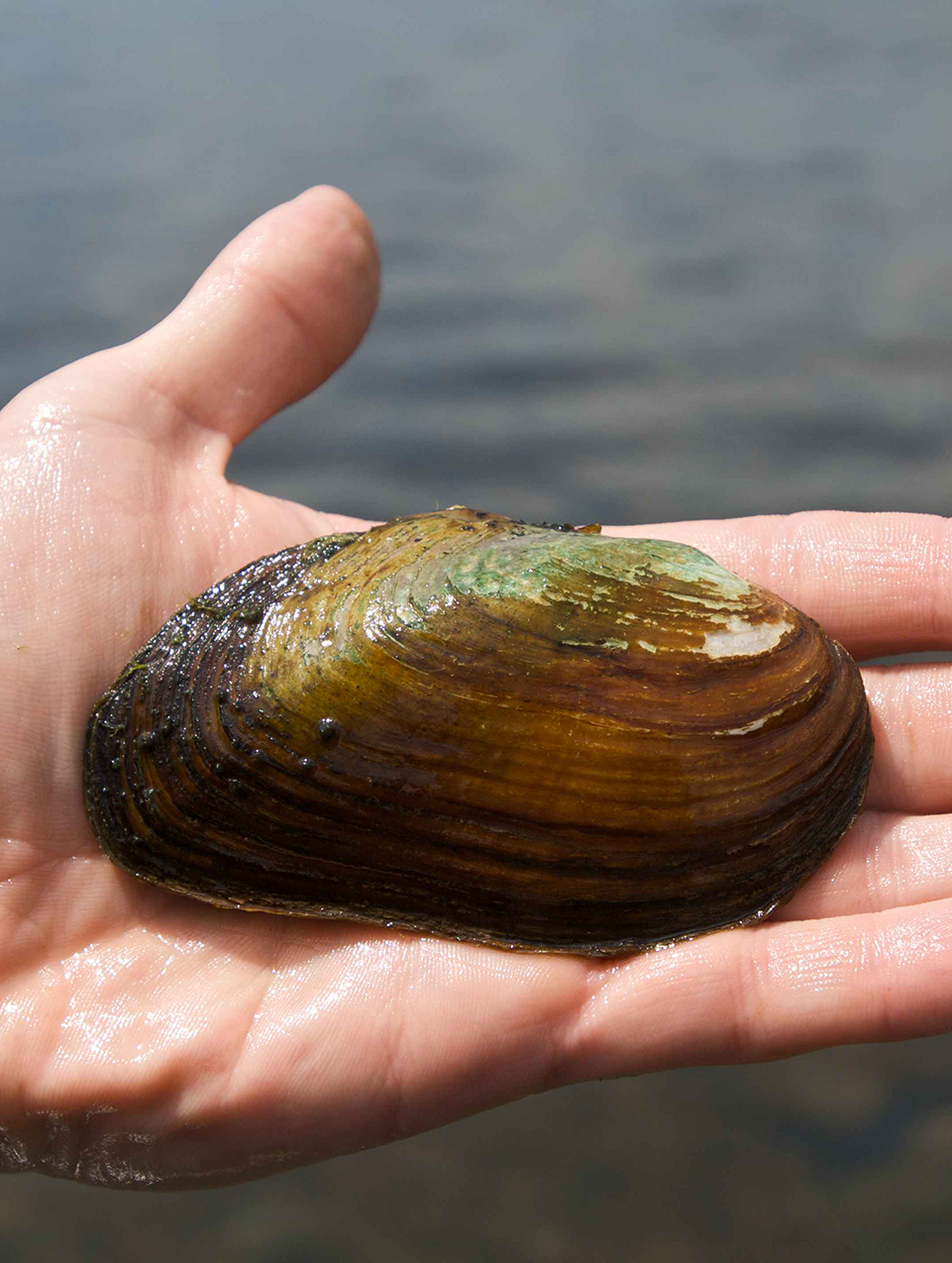When the Fairmount Water Works was built in the early 19th century to provide clean drinking water to Philadelphia, it was a feat of modern engineering. Steam engines and a dam across the Schuylkill River powered water wheels large enough to pump millions of gallons a day uphill to a reservoir atop nearby Fair Mount. Gravity did the rest, funneling the water through a network of mains and pipes to quench the growing city’s thirst and help abate outbreaks of yellow fever.
More than two centuries later, the water wheels have long stopped turning. The Philadelphia Museum of Art now sits atop the hill where the reservoir once was. And the Water Works houses a very different kind of water technology, one that predates the steam engine by a few hundred million years: freshwater mussels.
Deep within the Water Works’ cave-like confines, Lance Butler, senior scientist for the Philadelphia Water Department, oversees a laboratory no bigger than a low-rent Manhattan studio. Rows of shelves house little plastic drawers that can be pulled out and explored. Like kids in a candy shop, Butler and his team flit between them and rummage around. But they’re not hunting for a gummy bear or a Charleston Chew.
The drawers are filled with live mussels, and Butler prods them for answers.
“How much are they filtering?” Butler posits. “At what efficiency are they filtering? What are the effects of temperature and seasonality on filtration? What is the size scale? How much does a small versus a large animal filter?”
How much can these organisms, reintroduced at substantial levels, make a difference?”
— Lance Butler, Philadelphia Water Department
For the past seven years, Butler has sought to answer these questions. By studying freshwater mussels through their entire lifecycle — from nearly microscopic beginnings on the gills of a host fish to inch-long adulthood — his team is hoping to build the architecture of a promising new way to fight water pollution. Freshwater mussels are known to consume nutrients like nitrogen and phosphorus that can foul waterways, and even sequester harmful heavy metals. In theory, that could make them a valuable tool in cleaning up rivers and streams, a prospect that in recent years has also generated interest among some regulators and environmental groups.

But, all those little questions still add up to a big, nagging one.
“How much can these organisms, reintroduced at substantial levels, make a difference?” Butler asks.
The answer may soon be coming to a stream near you.
Over the next several years, a full-fledged mussel hatchery is set to be built at Bartram’s Garden, a historic public park nestled on the banks of the Schuylkill River just four miles downstream from the Water Works. Championed by the Partnership for the Delaware Estuary (PDE), the facility will have two halves, including a front-of-house education center for Bartram’s staff and visitors, and a mussel hatchery in the back. That’s where PDE staff will produce up to a million mussels per year — compared to just 40,000 at Butler’s lab — which will then be distributed to waterways through the region. It’s a major investment: about $21 million in total funding from public and private supporters according to Bartram’s, with $7.4 million of that going to construction of the hatchery.



Kathy Klein, executive director of PDE, says it’s the culmination of years of planning and visioning, which originated in large part with Danielle Kreeger, former PDE senior science director. The organization is one of 28 Congressionally-designated National Estuary Programs, which means it receives federal funding and works closely with state governments, the Environmental Protection Agency (EPA) and other stakeholders to “restore and protect” the Delaware River and Bay.
Over the past decade, as excitement grew around mussels’ water-cleaning potential, PDE secured funding from several stakeholders to support activity in the space, first with the creation of Butler’s lab, and then the much larger hatchery at Bartram’s.
“The water department was interested in doing this work as well, and that led to the construction of the demonstration hatchery” at the Water Works, Klein says. “That led to the realization that if we were going to try and really restore the population of freshwater mussels … then we really needed to upsize the production.”

But some worry that freshwater mussels aren’t ready for prime time.
John Jackson, a senior research scientist at the Stroud Water Research Center in Avondale, Chester County, says using mussels to try to clean up water at this point is putting the cart before the horse — or perhaps in this case, the bivalve before the science. For Jackson, the lingering questions around freshwater mussels are cause to proceed cautiously. He points to a 2019 paper he co-authored with several other scientists, including David Strayer of the Cary Institute of Ecosystem Studies in Millbrook, New York, which threw cold water on the rapidly-rising interest in freshwater mussels. He says there were two big “red flags,” the first of which was whether a push to propagate mussels could wind up introducing them into waterways where they haven’t historically existed, potentially causing significant ecological damage.
But a second, multimillion dollar question struck at the heart of the idea itself: are freshwater mussels actually a clean water solution worthy of such resources? Or are they distractions from tried-and-true methods of pollution reduction?
“The other [problem] was the promotion of this idea that the mussels would clean up the waterways,” Jackson says. “And there’s just no evidence. It creates a false expectation.”
Millennia of use, a decade of good data
Whatever their differences of opinion, those working on freshwater mussels in the Delaware watershed generally agree on the history of the bivalves, which stretches to the Cambrian period some 500 million years ago. In more recent millenia, their story began to intersect with humans locally, as some Native Americans took to eating them and using their shells for both decorative and utilitarian purposes.
This human-mussel relationship turned sour in the 19th century, when someone realized their shells made a great feedstock for button manufacturing. Subsequent overharvesting, an increase in water pollution and the advent of an industrial-era dam building spree caused their numbers to plummet: 70% of all freshwater mussel species are now imperiled or extinct in the United States, which Butler says adds to a bleak global picture in which the bivalve has become “the most imperiled invertebrate” worldwide.
Another problem is the relative lack of scientific interest in the species, compared to their more sought-after (and tastier) seafaring relatives, such as the Atlantic oyster. That has led to a dearth of scientific understanding of their biology, lifecycles and historic locations in the region, which has only begun to turn around over the past few decades.
Exactly where or why this modern interest in freshwater mussels began is tough to pin down, but various experts say there is undoubtedly a trend underway. Jackson says he’s now aware of at least ten large-scale hatcheries around the Mid-Atlantic, the creation of which he believes began to snowball once a few early efforts established best practices.
The trend also appears to be a diffuse one, with various public entities including the U.S. Fish and Wildlife Service, National Park Service, EPA, Pennsylvania Fish and Boat Commission and PDE, along with private research, conservation and academic organizations, all throwing various amounts of resources into freshwater mussels.
Jackson’s reservations on freshwater mussels notwithstanding, others say they don’t want the bivalve to get a bad reputation.
Scott Ray, a biologist with the PA Fish and Boat Commission, oversees a commission-owned mussel hatchery in Union City, about 30 minutes southeast of Erie in the Ohio River basin. Whereas the Philadelphia-area efforts focus on the so-called “ecosystem services” mussels can provide, Ray says his hatchery for the past several years has focused on supporting existing populations of mussels, whether by bolstering already healthy beds or propping up endangered species.
“Our main focus is going to be to keep the common mussels common, and keep the listed species from going extinct, and off the listed status,” Ray says.
Such uses are generally less controversial than propagating mussels for the express purpose of cleaning up a waterway. Also more widely accepted are mussels’ ability to stabilize streambanks, and their importance in supporting macroinvertebrate populations, particularly the tiny insects that underlie a healthy ecosystem for fish, according to Kelly Somers, a senior watershed coordinator for EPA Region 3.
For all of these reasons, Somers and colleagues say, the EPA generally plays a “supportive” role in freshwater mussel propagation, whether that be providing the service of an in-house dive team to help place new mussels in waterways, lending technical or scientific expertise, or in certain occasions providing funding: The agency helped secure about $750,000 in funding for the Bartram’s Garden hatchery via the federal Bipartisan Infrastructure Law.
Ultimately, agency staff believe mussels are an important “tool in the toolbox,” to blend with more traditional engineering and pollution control measures, even if their exact utility is currently fuzzier for some purposes than others, says Megan Mackey, national estuary team lead for EPA Region 3.
“EPA is very supportive of that marriage of traditional and innovative,” Mackey says. “Those nature-based technologies complement the tried-and-true engineering ones.”
Half-shell full or half-shell empty?
Still, there’s that little question of the Bartram’s hatchery.
Jackson believes it’s too much, too soon. He’s concerned about the lack of historical records on where freshwater mussels naturally existed. He notes the bivalves are not an indicator species that belong in just about every healthy water way. Combing Pennsylvania, there are plenty of high-quality streams where freshwater mussels aren’t found. So if anyone starts placing them in rivers and creeks without an understanding of whether or not they truly belong there, he worries they could be asking for trouble.
“That’s very bad conservation biology,” Jackson says.
But even if the placement is right, Jackson questions their overall utility for cleaning up waterways. He says mussels are known to be sensitive to water pollution, which makes him question the logic that they can also be relied upon to treat it. He also worries they’ll detract from existing regulatory methods: several experts say there is talk of the EPA accepting mussel propagation in some areas as a “Best Management Practice” (BMP), a regulatory term that essentially gives a targeted entity credit for meeting pollution reduction requirements. For its part, EPA spokesperson Kelly Offner said the agency is not “currently aware” of any instances where mussels are being used as BMP, but reiterated that the agency generally supports their use.
“We recognize the important ecosystem services that mussels and other bivalves provide. We have partnered with stakeholders on a wide array of activities to help restore and enhance mussel populations and habitat,” Offner wrote in an email.
Nevertheless, Jackson says the whole idea reminds him of the mid-20th century philosophy that waterways were “self-cleaning,” and says he’d prefer focus to be kept on reducing pollution at its source. Indeed, known pollution sources such as nutrient and pesticide runoff from human landscapes continue to contaminate the region’s waterways, as do billions of gallons of annual sewage overflows from Philadelphia’s aging sewer systems.
Our greatest success environmentally has not been asking nature to heal itself. When we remove the stressors that come from people, then nature heals.”
— John Jackson, Stroud Water Research Center
“Our greatest success environmentally has not been asking nature to heal itself,” Jackson says. “When we remove the stressors that come from people, then nature heals.”
Klein says the Bartram’s hatchery PENNVEST funding is in the form of a loan, which ostensibly will be paid back when the hatchery begins to sell mussels, potentially to regulated entities. But she freely acknowledges that the whole model is not guaranteed to work, and that mussels are not a silver bullet to clean up long-stressed waterways in any event.
“I think if we can work to restore these animals into our streams where they were historically abundant, there’s a lot of value in that,” Klein says. “At the same time … this is not going to solve the problems that we have with clean water.”
There’s also a solid upside for Bartram’s Garden. Staff will use the public portion of the new building to further the park’s mission of reconnecting nearby underserved neighborhoods with their river. New facilities will include public science labs and a kitchen space for use by Sankofa Community Farm.
The activity going on in the hatchery next door will also help demonstrate to visitors the importance of striving to clean up the watershed, says Caroline Winschel, director of development and communications at Bartram’s.
“We see the importance of seeing this project advance,” Winschel says. “It’s very exciting for us … to think about world-class science happening here in a public park, and to think about being able to make that accessible and make that part of how the neighborhood thinks about the river in our backyard.”
This story was produced in collaboration with Delaware Currents.



 This content is a part of Every Voice, Every Vote, a collaborative project managed by The Lenfest Institute for Journalism. Lead support for Every Voice, Every Vote in 2024 and 2025 is provided by the William Penn Foundation with additional funding from The Lenfest Institute for Journalism, Comcast NBC Universal, The John S. and James L. Knight Foundation, Henry L. Kimelman Family Foundation, Judy and Peter Leone, Arctos Foundation, Wyncote Foundation, 25th Century Foundation, and Dolfinger-McMahon Foundation. To learn more about the project and view a full list of supporters, visit
This content is a part of Every Voice, Every Vote, a collaborative project managed by The Lenfest Institute for Journalism. Lead support for Every Voice, Every Vote in 2024 and 2025 is provided by the William Penn Foundation with additional funding from The Lenfest Institute for Journalism, Comcast NBC Universal, The John S. and James L. Knight Foundation, Henry L. Kimelman Family Foundation, Judy and Peter Leone, Arctos Foundation, Wyncote Foundation, 25th Century Foundation, and Dolfinger-McMahon Foundation. To learn more about the project and view a full list of supporters, visit 





